Living Labs Forum 2006
Living Labs Forum 2006 brought together Living Lab leaders from 12 European cities, as well as business executives, methodology experts and policy makers. Held in Barcelona, the event covered experiences, emerging projects, results and opportunities and lead to a rich exchange between those that are bringing new advanced mobility services to Europes citizens, businesses and visitors.
After three-and-a-half days of extensive presentations, discussions exchanges and intensive networking, the Living Labs Europe Forum 2006 came to a close on Wednesday in Barcelona.
Our days in Barcelona, supported by the mClusters community and our local Living Labs Catalunya partners, was attended by leaders of more than 12 Living Labs and mClusters – representing local / regional and trans-national public agencies, leading universities, small- and medium-sized companies and multi-national corporations. Co-located with the Internet Global Congress , the event was held in an entrepreneurial context with more than 3.000 ICT professionals and their show-cases around us.
A broad spectrum of issues was reviewed, with experts or leaders in each field facilitating the discussion. Professor Jan Annerstedt of Living Labs Europe kicked off the sessions with giving the stage to the European dimension of Living Labs.
Angelos Ktenas and Marika Kaliff reviewed the current state and considerations of European policy on Living Labs, introducing their departmental and directorate (DG Information Society and Media) objectives. Reflecting on the key policy and funding frameworks provided via i2010 and CIP (Competitiveness Innovation Programme) progress on development of eWork Living Labs was reported. Marika Kaliff outlined the work on the initial work done today in the definition of Living Labs concepts and how these can integrate into EU policy frameworks.
Pelle Ehn, Professor at K3, the School of Arts and Communication at Malmo University and internationally recognised expert on participatory innovation and design followed the EU policy perspective by placing Living Labs into a historical context reaching into the early and mid 20th century and placing Living Labs into a line of models and experiments in linking technology and solution design methods. Prof Ehn outlined both the limitations faced by traditional participatory design as well as the emerging instruments that can be used as components in advanced Living Labs – including the ecologies of artefacts that conceive technology development of an appropriation and integration of habitual environments. Drawing our attention to design not as a limited stage, but also an activity that can span into the post-design stages of training, appropriation and socialising efforts Professor Ehn also pointed at the significant disciplinary implications on design as a more holistic process reaching beyond the conception and production stages.
A key concern was raised by the floor, focusing in particular in the motivational challenges in Living Labs – an issue later reflected also during the methodology workshop run by Prof Ehn. Living Labs leaders often face barriers of motivation or prioritisation to bring about cross-sectoral or just inter-departmental change. Motivating limited user groups in a hospital or similar environment may be only one component of mobilising a broader stakeholder community into participatory design.
Herein, according to Ehn, lies both a great challenge and opportunity. Mass participation, in which more than 2000 users can take part are possible and practiced most widely in the practice of architecture and urbanism. Defining the territory of engagement and scaling-up methodologies may be a new field of opportunity due to the territorial make-up and anchoring of Living Labs to particularities of ‘place’.
Angelos Ktenas reflected also on the EU Policy side, which offers the programmatic frameworks to address motivational issues, yet offer no instruments or special attentions at this stage to this aspect of Living Labs operations. It appears to emerge that reporting the experiences gathered in the Living Labs Europe community may be a particularly important contribution to support the ‘triggering of engagement’ (Annerstedt) that could be fed into the FP7 Living Labs framework. These conceptual and policy framework discussions were followed by the entrepreneur’s perspective on Living Labs.
Anders Halldin, CEO of Woize International (a VoIP operator) outlined his company’s strategy in utilising Living Labs Europe as an instrument to innovate in direct collaboration with end-user communities across Europe. Living Labs, according to Halldin, continue to add significant elements of differentiation to Woize’s business development and solution portfolio, which is integrated into municipal messaging platforms, provides free telephony, SMS / wireless commercial transactions and brandspace to local and international networks. Woize already collaborates with Living Labs in Sweden, Germany and Catalunya via Living Labs Europe to go beyond test-bed functionality by proactively shaping user-demand. Like all other speakers on the panel, it was made clear that test-beds are only a component of a Living Lab – with the broader challenge lying in the organisational and leadership implications.
Leadership, unsurprisingly, featured as a key success factor in the exchange of experiences from Living Labs that was presented by representatives from Vaestervik, Kalmar region in Sweden, and in Hamburg.
Hakan Brynielsson, Managing Director of the Kalmar County launched the second session with an introduction into the digital society development in Kalmar. Already in the mid-late nineties plans were developed to implement a regional roll-out of broadband services going in conjunction with dramatic reorganisations in the public sector. A significant enabler for the successful (mainly infrastructural) investments in Kalmar was a leadership ability to consolidate fragmented investment funds for 12 municipalities in the region to establish and implement a regional strategy.
Picking up on the regional framework, Harald Hjalmarsson, Mayor of Vaestervik (37.000 inhabitants) placed this development into a context of the municipal trauma when Electrolux transferred 1.000 jobs from Vaestervik to Hungary.
Instead of striking or fighting the inevitable, public leaders took a bold decision to address the future head-on. Setting in motion the Living Lab Vaestervik not only advanced technologies but conepts for rationalising and rethinking public administration has made Vaestervik an international reference for mobile solution development. mTourism, mStudent, mCitizen are the priority areas in which advanced concepts have become realities. Over the past year, leaders from other Living Labs have visited Vaestervik and international collaborations have been triggered by Living Labs Europe.
Following this local success story of a small community (which included also representation by the winners of the mStudent contest and the headmaster), the City of Hamburg and its stakeholders presented a spectacular view of its Living Lab. Jens Bley (Living Labs Germany) presented the ‘Mobile Marketing in Urban Spaces’ concept, which draws on a synthesis of traditional and mobile media and marketing channels into a holistic urban information space. Combining research findings by Simon Blake from Berlin and extensive media experience in Hamburg, this concept is a concept for Europe with already key stakeholders aligned from the business and public sector community in Hamburg. Exploitation of holistic licensing fees can effectively quadruple licensing revenues for the City of Hamburg in tendering an interactive outdoors advertising and urban furniture package in 2008 – a triggering event in what is anticipated to be a European roll-out.
Whilst presented as a sound business proposition, the concept addresses also important informational and navigational needs by citizens and the objectives of municipalities to promote mGovernance services. The project drives a network of partners in Hamburg as well as a European consortium of Living Labs partners in Catalunya, Sweden and Budapest seeking to commence Market Validation in the coming months.
Uwe-Jens Neumann, Managing Director of Hamburg’s Economic Promotion Agency, provided the municipal perspective and leadership strategy behind the Hamburg Living Lab. Anchored within the professional network http://www.hamburg-media.net/ (2300 members), established already for 10 years, with experiences in being the first European municipality to roll out sponsored WiFi coverage in the city-centre. As a Living Lab, Hamburg will draw on these unique infrastructures and the expertise inherent in Germany’s leading hub for media businesses. Complementing the mobile marketing (and related) projects, networking events (“Living Labs Lounge”) provide the social environment in which ideas, collaboration opportunities and inspirations are exchanged.
In the questions raised to the panel, important issues relating to the various forms of Public-Private-Partnerships in Living Labs were raised to the representatives from Vaestervik, Kalmar and Hamburg. The separation between commercial and public interest remains a challenge, as the innovations intended require close collaboration and forward-looking co-investment. If these were to be followed by extensive tendering procedures it would disrupt the private sector willingness to invest – yet it is also the public interest that calls for transparent decision making in such processes. Harald Bynielsson confirmed this concern – as a day-to-day challenge without simple recipes.
Yet, it was a comment by Mr Hjalmarsson that set clear the ambition by the Mayor of Vaestervik as challenging preconceptions on municipal services. H e expressed his goal to bring a large percentage of tax-payers money onto their mobile device to give them greater freedom in selecting public services.
A round-table facilitated by Pelle Ehn addressed Living Labs Methodology in response to the cases and experienced expressed. Whilst test-beds presume a service to exist, a Living Lab project shapes demand in close collaboration with the end-user. Ideally this is followed by a strong user-participation in the design process – an aspect that he felt was yet to be fully achieved in the experiences to date.
In Vaestervik and Hamburg, the involvement of end-users in the design could generate unforeseen results that should also draw on ethnographies – to follow, ask and search in a non-linear process. Electrolux has made significant recoveries when it began to integrate social probing, prototyping and user participation into a new design process. Tobi Schneidler, of M.A.O. Works (London) introduced the promising practice (and now industry) of experience modelling – as a service design industry – of which components could be used to enrich Living Labs processes. Experiences from
Living Lab Sant Cugat confirmed the prototyping methods, where simple technologies (SMS) were deployed – yet it was the internal operational structures that continued to prove most challenging.
Pelle Ehn outlined a significant methodological advancement that Living Labs could contribute to participatory design. Living Labs establish longer-term communities of collaboration that last beyond the projects. If this is to be achieved, community building ought to be integrated into the process of establishing Living Labs – as has been done in various regions. This in combination with larger scale user participation (2000+) could lead to new forms of design, unpredictable results and a truly unique Living Labs offering.
Sascha Haselmayer, of Living Labs Europe and Coordinator of Living Labs Catalunya introduced the progress made in Catalunya - including the implementation of the branding efforts through prioritised project lines. International networks have been launched to structure collaborative projects along the lines of mStudent, mTourism, mVisitor, and mMarketing connecting companies, public agencies and research groups with their international counterparts.
Christer Asplund, of Living Labs Europe, hosted the sessions on reporting the results of the mWatch Europe studies findings on Mobile Readiness in Europe. 25 Cities were reviewed, leading to a number of rankings according to the Mobile Readiness Index.
Complementing the index, a review of Kaleidoscope cases for the most innovative projects and regional conditions took place, with presentations from 11 European regions. Overall, findings of more than 80 innovative mobile projects were presented in a round-table atmosphere triggering an exchange of experiences, opportunities and even investor interest.
Tuesday kicked-off with a spectacular presentation on ‘Mobile Marketing in Urban Spaces’ by Simon Blake and Jens Bley (Living Labs Germany). Covering the detailed concept (including demonstrations and prototypes) the presentation triggered a lively discussion of limitations and opportunities in Europe. A key factor, in some regions, may be the regulation of public vs private contents – yet overall the added-value of a European vision for such a concept was recognised. In particular, its convergence of various existing components already operational in various Living Labs – integrating also free telephony and Bluetooth services – helped to bring the level of technical feasibility to trigger discussions about market validation.



A roundtable on mTourism chaired by Christer Asplund reviewed the current initiatives in the regions present, plus an international comparison with offerings in Asia and the United States. Whilst many services are already available in Estonia, these do not sufficiently seem to integrate with traditional (including outdoor-advertising) media to build awareness. Tourists / Visitors are not informed about the great variety of services, including the ringing of church-bells via SMS in Tarttu. Arturo Ortega, of the Barcelona Living Lab ( Fundacion Barcelona Digital) showed confidence in achieving the objectives established in the Brand Manual for Living Labs Catalunya in relation to the 2007 3GSM World Congress which should serve as a showcase for new content and visitor services in Catalunya. In addition, a pilot of the new 7010 mobile service for citizens (including city agenda, map, information) was presented that could act as a platform for further Living Lab services.
A particular highlight was the discussion of food clusters in various European regions to develop food related solutions. Interest from Sweden, Piedmonte, Catalunya, Oresund, Budapest, and Portugal was particularly strong to link unique traditions, expertise, logistics and products with advanced mobile services – such as recipes on demand, tour guides and others. A Food Living Lab is in the making in Grythyttan, with an international Living Lab event planned in October 2006 that could trigger European networking. Furthermore, linkages can actively be built with the Food networks in INNOVA and InvestorNet Food Group.In all, the roundtables and sessions produced an extensive overview in 3 days – which is only covered in small fragments in this article.
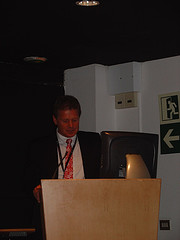
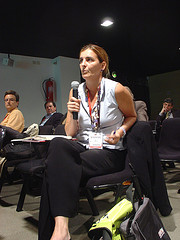
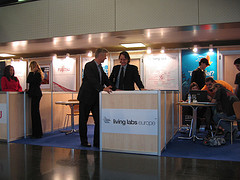
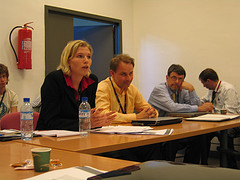
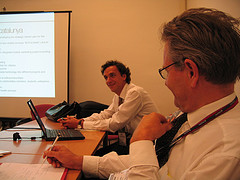
November 12th, 2006 at 3:56 pm
[…] mWatch methodologies, consisting of a mixture of indicators (Mobile Fluency, Innovative Climate, Management Capacity) go a long way to capture the localised Mobile Readiness. Demand and lead-users are identified, together with technical competences, the ability to innovate as well as the capacity to manage and lead horizontal projects. The Kaleidoscope of Innovative Projects showcases the leading projects and entrepreneurs exploiting or even surpassing the framework conditions – recognising the entrepreneurial and innovative spirit. mWatch intends to provide insights into emerging lead markets – as can be said about the top performing Estonia. Whether this lead market will be able to deliver the exportable goods, set international standards or even just sustain its position will remain to be seen. […]
September 2nd, 2007 at 3:29 pm
Runescape Money Blog
I have written a followup to this on my blog. Feel free to check it out if interested. -Louis— This post was created by Comment Poster. Want to post thousands of comments to blogs instantly and increase your visitors exponentially? Check it out he…